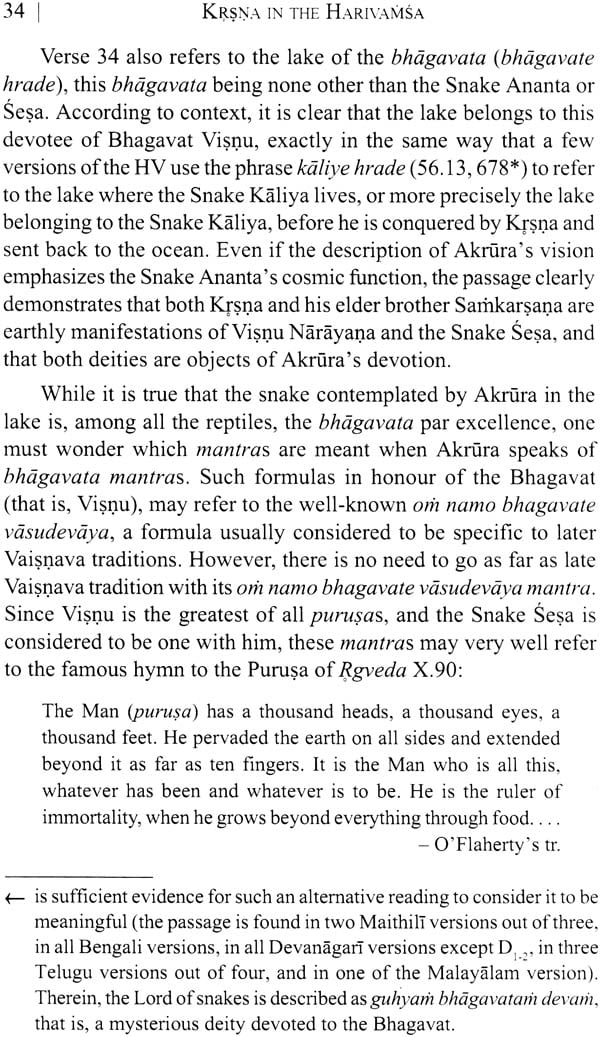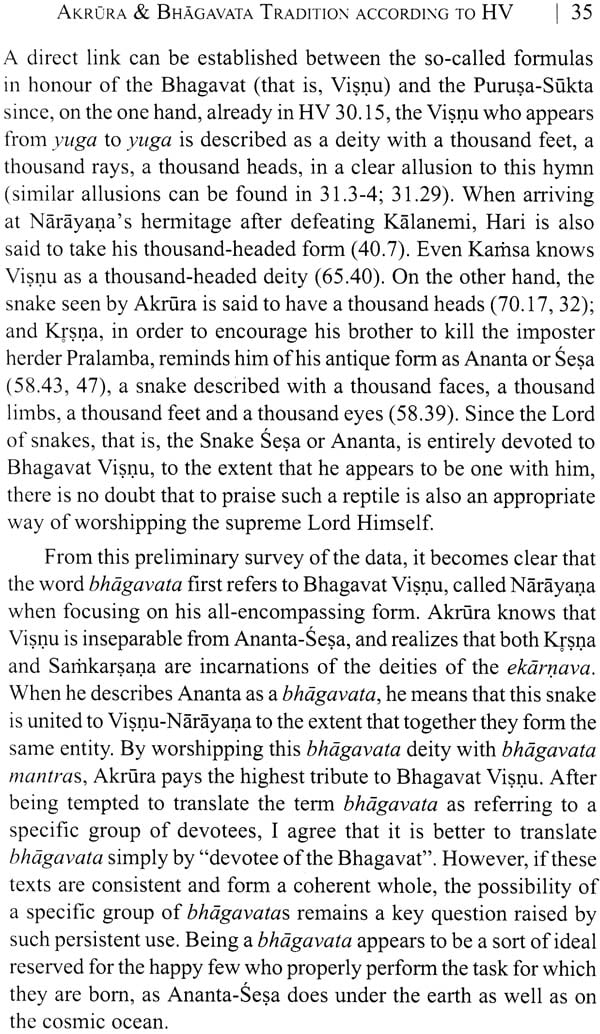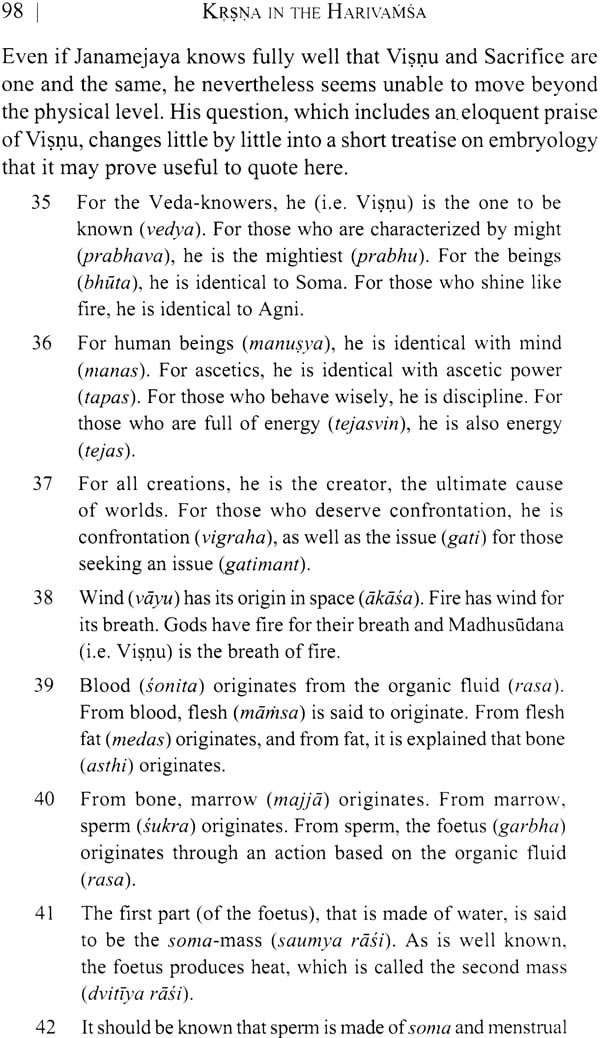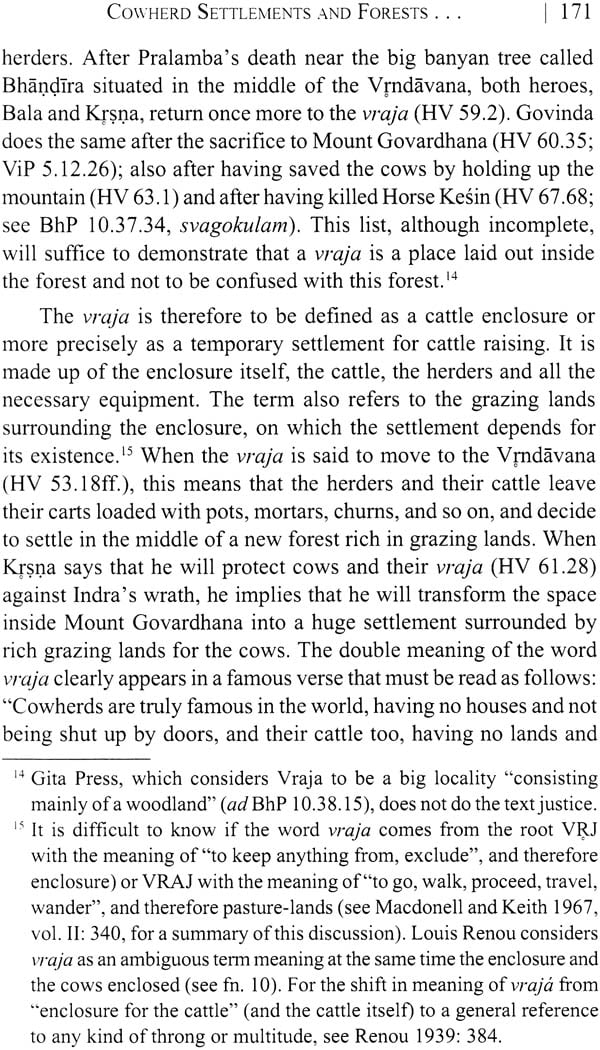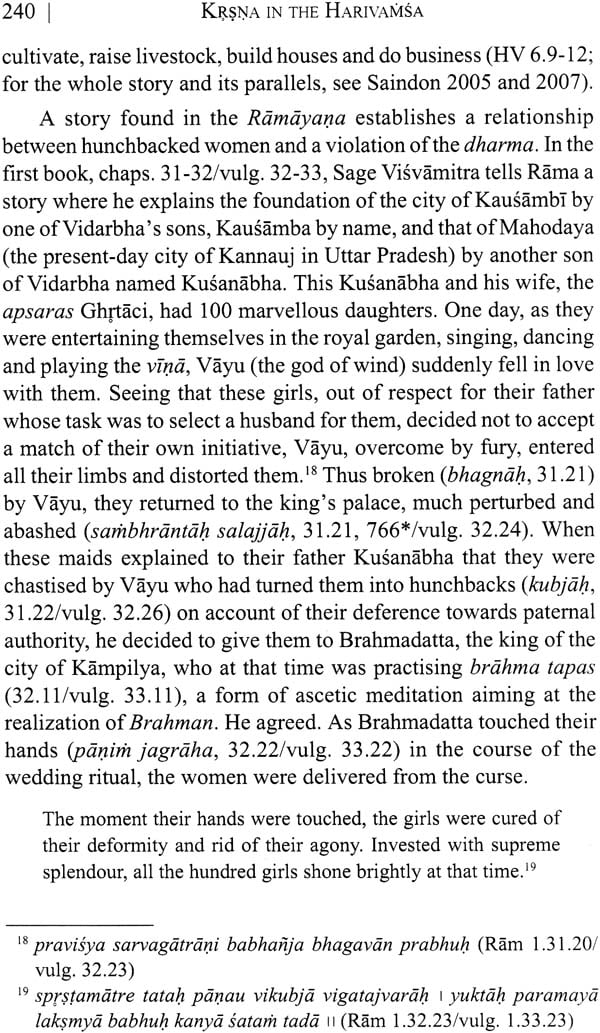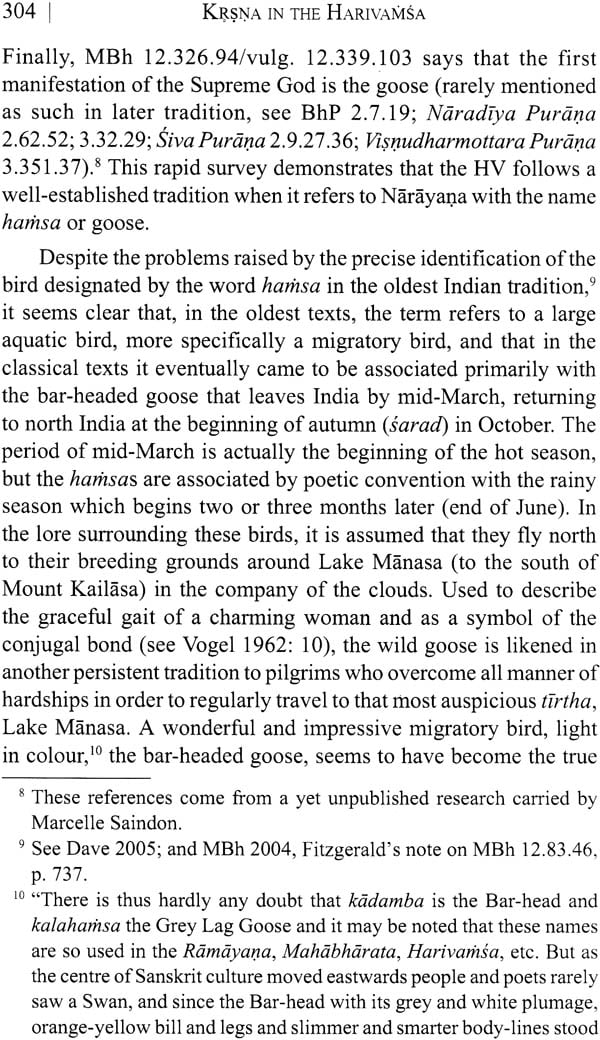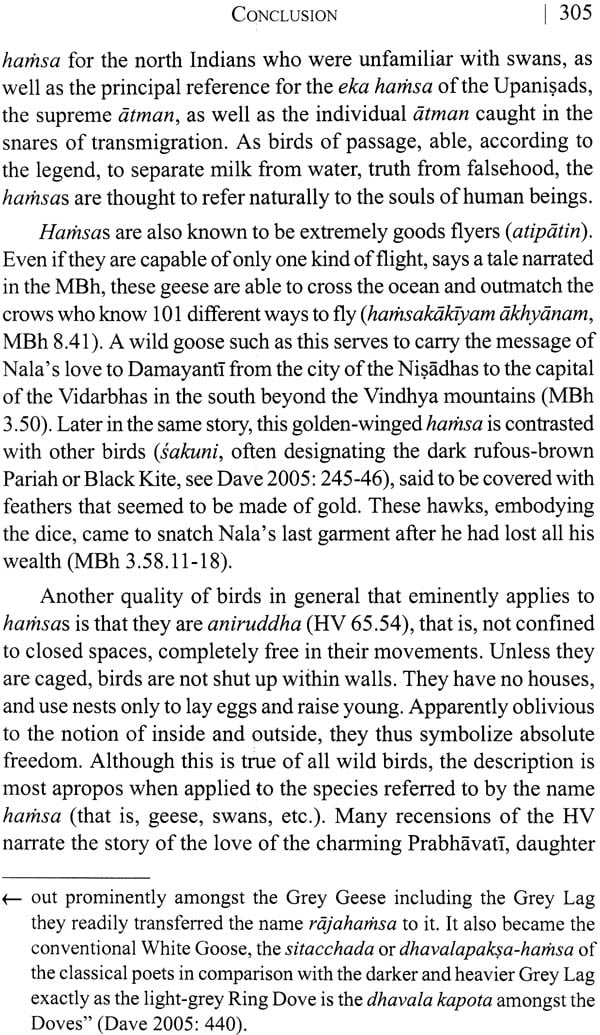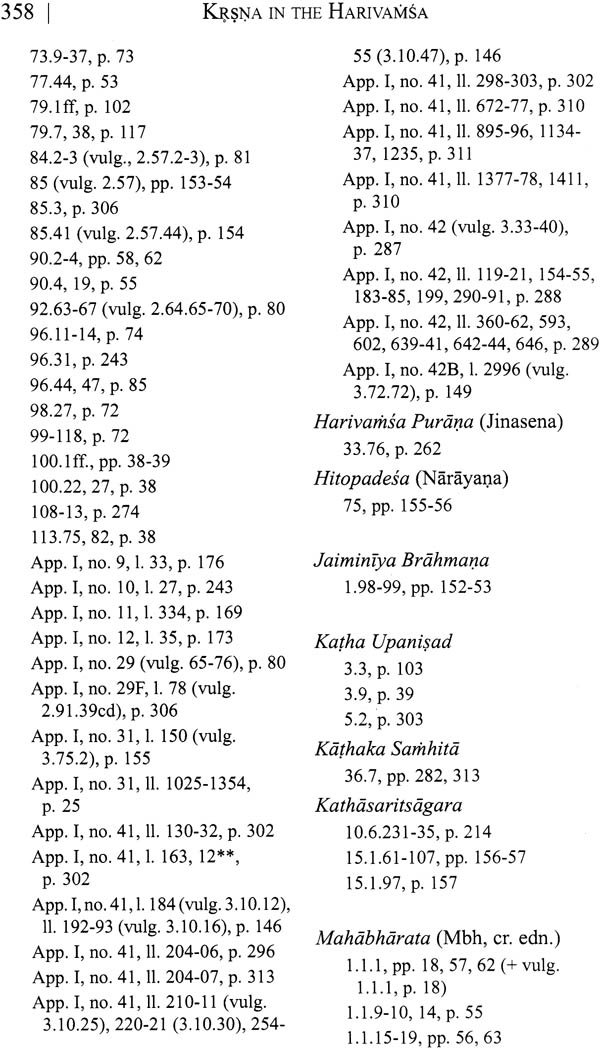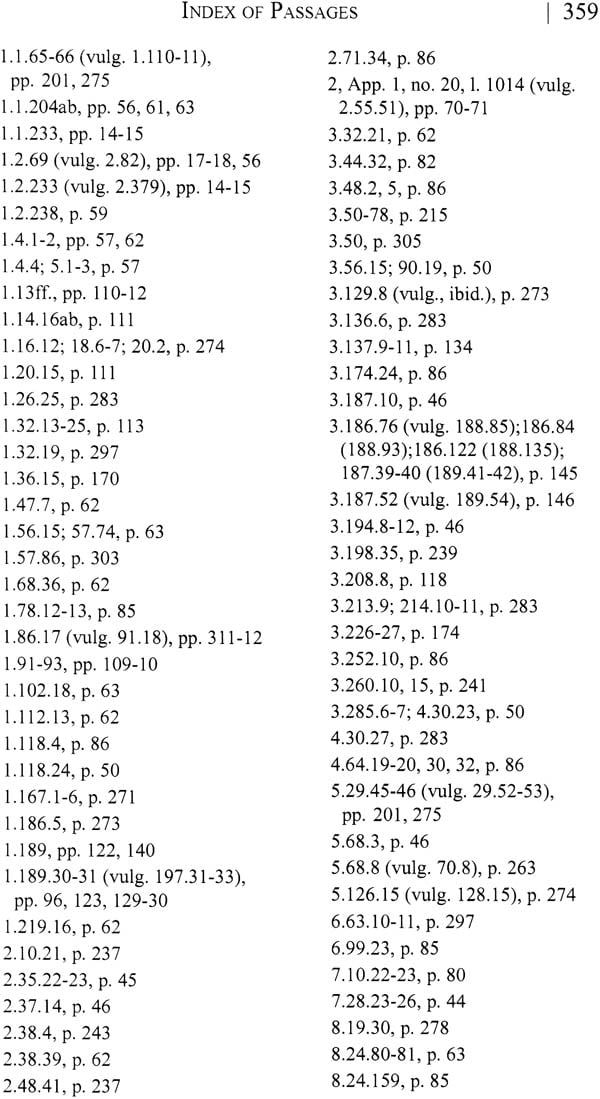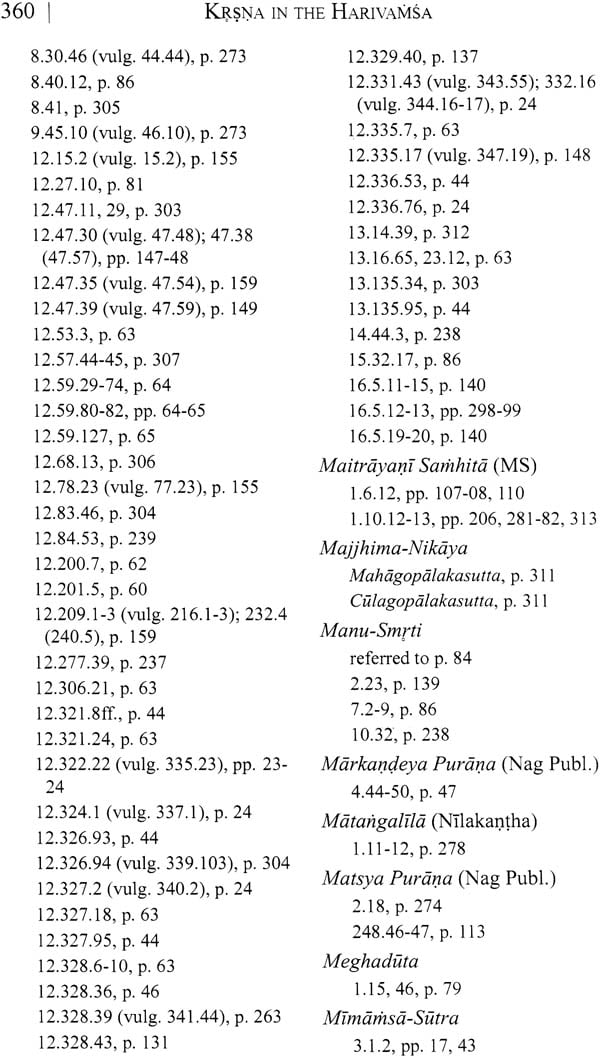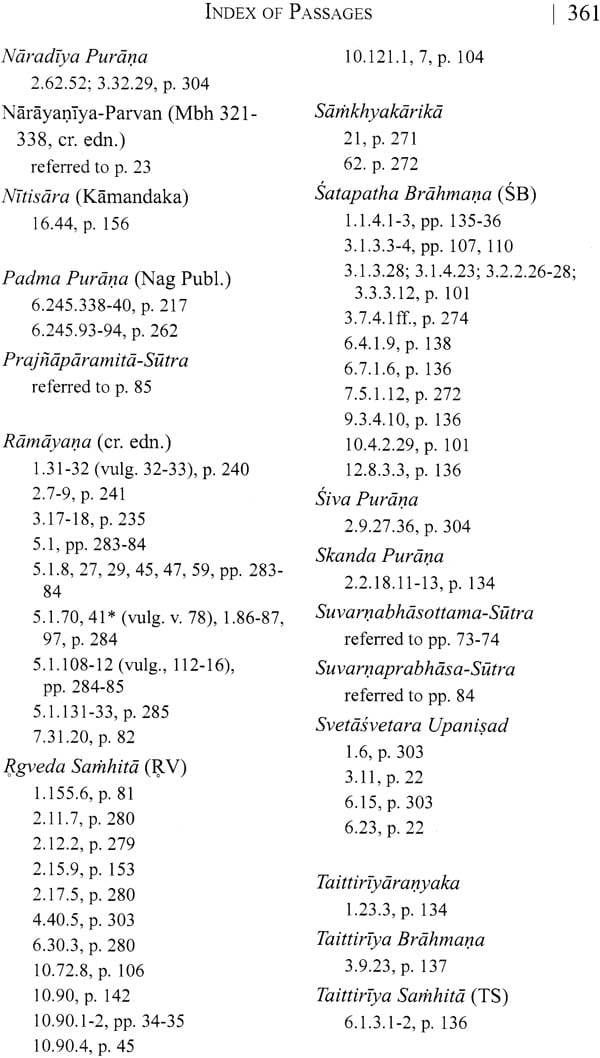
Krsna in The Harivamsa (Vol. 1: The Wonderful Play of a Cosmic Child)
Book Specification
| Item Code: | NAK705 |
| Author: | Andre Couture |
| Publisher: | D. K. Printworld Pvt. Ltd. |
| Language: | English |
| Edition: | 2015 |
| ISBN: | 9788124608241 |
| Pages: | 370 |
| Cover: | Hardcover |
| Other Details | 8.5 inch X 5.5 inch |
| Weight | 710 gm |
Book Description
Written over a thirty-year period, the thirteen texts of this book - some of which have been updated, others translated from the original French - address various aspects of Krsna’s childhood in the Harivamsa. As a part of a continuous effort to better understand this oft-neglected complement to the Mahabharata, the present book demonstrates that these stories of Krsna's childhood were carefully composed by brahmanas who knew fully well what they were doing.
During the ten or so years he spends as a herder in the forest surrounding Mathura, Krsna prepares himself to kill the evil king Kamsa: when packs of wolves spring from the hairs of his body, he manifests his destructive power; he appears as a true avatara when he dives into the Yamuna to subdue the snake Kaliya; he reveals himself as a new Brahma able to create a new world when he uplifts Mount Govardhana with which he has just identified himself, then sheltering cows and herders in his own body.
It is author's contention throughout these chapters that these episodes cannot be dismissed as a hotchpotch of legends borrowed from the Abhiras or similar pastoral tribes. Neither does one do justice to the genre when one reinterprets the story symbolically, as if it were the product of an overactive imagination. Rejecting these positions, the author instead attempts to show here how these talented storytellers carefully crafted a narrative, often using material drawn from their own Vedic tradition, in order to address the new concerns of their audiences.
Andre Couture is an Indologist and professor of the History of Religions at the Faculte de theologie et de sciences religieuses, Universite Laval, Quebec, Canada. Couture has published on a wide variety of topics. Of special interest in this context are a number of articles on Krsna mythology and the translation of various texts including chaps. 30-78 of the Harivamsa (L'enfance de Krishna, 1991); Appendix I, no. 41, of the Harivamsa (La vision de Markandeya et la manifestation du Lotus, 2007); Bhasa’s Balacarita (in Theatre de 'Inde ancienne, ed. Lyne Bansat-Boudon, 2006); and with Christine Chojnacki, Hindu, Buddhist and Jaina texts related to the Harivamsa (Krishna et ses metamorphoses dans les traditions indiennes. Recits d' enfance autour du Harivamsha: PUPS, 2014).
Over a period of several decades, my research has been devoted primarily to the study of Krsna and the Harivamsa (HV). The thirteen texts of this book, most of which were previously published either in French or English, form the first part of a collection in which the fruit of those years of study will be gathered together.
More than forty years ago, as I was looking for an avenue for future research, my Sanskrit teacher, Prof. Anne-Marie Esnoul, encouraged me to attend the seminar which Prof. Olivier Lacombe was scheduled to offer that following year (1972-73) at the University of Paris-Sorbonne on the Tenth Book of the Bhdgavata Purana (BhP). In preparation for the seminar, I spent my summer vacation reading and re-reading Hauvette-Besnault's French translation of Krsna's childhood. As a neophyte, I was unable to make much sense of its many philosophical digressions and descriptions of wonderful deeds. In my attempts to become better acquainted with Krsna's adventures, I eventually discovered Wilson's old translation of the Fifth Book of the Visnu Purana (ViP), which provides a more straightforward version of Krsna's biography; one probably written a few centuries earlier than the BhP. Finally, I came across the first account of Krsna's life among the herders surrounding the city of Mathura in the HV, a book considered to be a supplement to the Mahabharata (Mbh). Given the secondary status accorded to the HV and the fact that A. Langlois' early French translation (1834-35) of the text was more a paraphrase of the Sanskrit than a true rendering, it took me some time to realize how important this text was to an understanding of Krsna's childhood.
A few years after my Ph.D. dissertation (1977), the objective of which was to compare the three oldest Sanskrit texts dealing with Krsna's childhood, I decided to translate that part of the HV which deals with this period of Krsna's life, i.e. chapters 30 to 78 of the Critical Edition (Couture 1991). As the translation progressed, new hypotheses and insights gradually emerged which I shared at international conferences and in several publications.
The first four texts included in the present book deal with general issues that any serious reader of the HV will eventually have to address. The fourth of these texts, having reviewed the standard scholarship on the thorny question of the date of composition of the HV, proposes a down-to-earth approach ("Possibility of Assigning a Date to the Harivamsa?"). In its present form, this survey is a completely new essay, even if several pages overlap texts which I had already published on the subject or discuss hypotheses which I had previously formulated. The three other texts examine specific words which have become cliches in a large part of current scholarship, so much so that a fresh and completely new examination appeared to me to be the most promising and realistic way of arriving at an understanding of their underlying meaning. Khila is the first of these words. In spite of the common and apparently obvious translation, the term does not correspond to the English notion of "appendix", but refers rather to a supplement received from elsewhere for the sake of completion, fulfilment or elucidation ("The Harivarnsa: A Supplement to the Mahabharata", 1996). The next word is bhdgavata, a term encountered several times in the episode of Akrura's ablutions in the Yamuna waters. In a text entitled "Akura and the Bhagavata Tradition in the Harivarnsa" (1986, revised), I argue that, for the first time in history, the HV provides a real context for the use of this epithet. This socio-religious context, that should not be underestimated, clearly demonstrates that the term is used to designate those who accept Visnu as the supreme deity, thus transposing their loyalty to their king (rajabhakti into total subservience to the Bhagavat. The third word, purana, is regularly used in the HV ("The Harivarnsa and the Notion of Purana", 2003). Whereas important earlier research left the impression that the meaning of the word had already been clarified, a close reading of the HV makes it clear that the model of a Purana as having five main components (pancataksana) does not make sense in that context. When the Puranas are examined with the sole specification that they should be considered to be a Vedic complement, it becomes clear that they constitute a set of legitimations developed over time in response to the challenges of an emerging complex urban civilization.
The second section of the book focuses on the births of Krsna and his elder brother, Samkarsana. The first two texts concern the ways in which both of them are born, since, according to tradition, both brothers were born either from their natural parents, Vasudeva and Devaki ("The Story of Samkarsana and Krsna's Births: A Drama Involving Embryos", 2009), or from a white and a black hair ("Samkarsana and Krsna's 'Hair' Births", 2012). Here, these apparently disparate narratives are taken seriously, contextualized and appropriately analysed. Instead of being viewed as remnants of primitive tribes which defy interpretation, these stories reveal a rather precise structure and appear to be strangely connected to certain commentaries found in the Brahmanas. The third text of this section ("The Problem of the Meaning of Yoganidra's Name", 1999) deals with the compound yoganidrd used as a designation for Goddess Ekanamsa, the name given to Krsna's elder sister who was born in King Kamsa's cowherd settlement to protect Krsna and Samkarsana's births. Instead of connecting yoganidrd to a particular state of meditation, I associate the word with that kind of fake sleep (yoganidra) which is well attested to in classical texts. Even a king protected by his best fighters needs such a sleep, if he is to dominate the world.
The third section of the book deals with the period of childhood itself. This set of stories is very complex, and no one can pretend to encompass all of them. In choosing a select number of episodes and problems, I hoped to indirectly address some of the most important topics. The first breakthrough made in terms of an accurate reading of these ancient stories of childhood came when, in 1974, I realized that, in spite of the current translations and recent sectarian biases, it was no longer possible to defend the position that the Sanskrit word vraja refers to the region of Braj, or that gokula and vrndavana refer to the villages of Gokul and Brindaban. After a complete survey of the HV, ViP and BhP, I then decided to add a completely new chapter to my 1977 dissertation, a chapter that was published as "Cowherd-Settlements and Forests in Three Ancient Versions of Krsna 's Childhood" in the Journal asiatique in 1982. The second breakthrough occurred when I began to examine the sequential arrangement of the various episodes of Krsna's childhood while translating the HY. The summary of these investigations gave rise to the second text of this section, "Krsna's Childhood according to the Harivamsa: Study of the Composition of the Narrative" (1989). I had realized that it was necessary to go beyond the distinction between royal and pastoral episodes emphasized by Charlotte Vaudeville, and came to the conclusion that the key episodes of Krsna's childhood - Krsna ' s transformation into packs of wolves, the submission of the Snake Kaliya and the uplifting of Mount Govardhana - should be linked to the figure of the supreme deity who destroys, maintains and recreates the whole world. No doubt, the young Krsna who used to run in the forests surrounding Mathura was the same unique god whom the sage Markandeya watched lying on the back on a banyan leaf in the middle of the cosmic ocean.
The remaining texts address a number of other problems. In the more recent article, “Kubja, the Hunchbacked Woman Uplifted by Krsna" (2011), I developed an observation made during the 1970s, that there is an underlying similarity between the way Krsna heals the hunchback and the way he uplifts Mount Govardhana. As this long study evolved, other important feminine figures such as Putana and Surpanakha became sources of comparison. It may also be said in passing that, considered against the backdrop of this more recent research, my 1999 article, "Krsna's Strange Name of Damodara'' (Brahmavidya, Adyar), now appears far less speculative. The entire context of this episode, it seems to me, favours an interpretation of the mischievous child as a reference to the supreme Purusa, who grinds and devours the whole world (the mortar), and who stays in close relationship with the Snake which represents the Remainder of the world (the rope), even as he laughs in the middle of the dharmic and adharmic forces present in the universe (the arjuna trees).
I conclude this first set of texts with an article entitled "Birds, Herders and Yogins in the Harivamsa". In this essay, I advance the novel idea that Krsna's childhood in the HV intermingles seamlessly winged mountains and wild geese, simple cowherds and detached yogins. Written in 2006, as part of a Festschrift in honour of Prof. Pierre-Sylvain Filliozat, neither this article nor the Festschrift was ever published. I include it here as a token of gratitude for this great scholar's indefectible friendship and valuable help.
The articles in this collection which were published between 1995 and 2008 were funded by the Social Sciences and Humanities Research Council of Canada. I am indebted to those scholars who commented on drafts of the various chapters or debated this or that thesis defended in this book with me. At the risk of omitting other important contributions, I would particularly like to mention Christopher Austin, Madeleine Biardeau, Gerard Colas, Anne- Marie Esnoul, Pierre-Sylvain Filliozat, Phyllis Granoff, Marcelle Saindon, Charlotte Schmid and Ganesh Umakanth Thite. My sincere gratitude to all of these scholars and to all those who, knowingly or unknowingly, encouraged me to continue my research on the HV. Since English is not my mother tongue and since many of these articles were first published in French, I would also like to thank Robert Hurley, Christopher Austin and Elyssa Marcoux-Bissoondath for the linguistic revision of this book.
| Volume I | ||
| The Wonderful Play of A Cosmic Child | ||
| Abbreviations | vii | |
| Introduction | 1 | |
| Part 1: | The Harivamsa, Genre in Context | |
| 1.1 | The Harivamsa: A Supplement to ;the Mahabharata | 9 |
| 1.2 | Akura and the Bhagavata Traditions according to the Harivamsa | 22 |
| 1.3 | The Harivamsa and the Nation of Purana | 52 |
| 1.4 | Possibility of Assigning a Date for the Harivamsa | 67 |
| Part 2: | Krsna's Birth in the Harivamsa | |
| 2.1 | The Story of Samkarsana and Krsna's Births: A Drama Involving Embryos | 91 |
| 2.2 | Samkarsana and krsna's Hair" Births | 120 |
| 2.3 | The Problem of the Meaning of Yoganidra's ;Name | 144 |
| Part 3: | Krsna's Marvellous Childhood in the Harivamsa | |
| 3.1 | Cowherd-Settlemtns and forests in There Ancient Versions of Krsna's Childhood | 163 |
| 3.2 | Krsna's Childhood according to the Harivamsa: Study of the Composition of the Narrative | 180 |
| 3.3 | Kubja, the Hunchbacked Women Straightened Up by krsna | 214 |
| 3.4 | Krsna's Strange Name of Damondara | 260 |
| 3.5 | The Winged Mountains: Variations on a Vedic Theme | 277 |
| Conclusion: Birds, Herders And Yogins In The Harivamsa | 301 | |
| Bibliography | 315 | |
| General Index | 338 | |
| Index of Passages | 352 |
